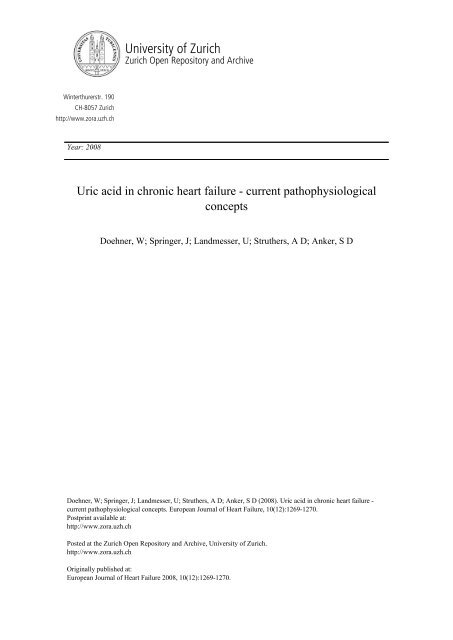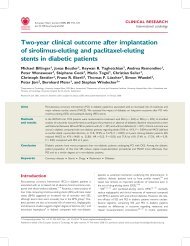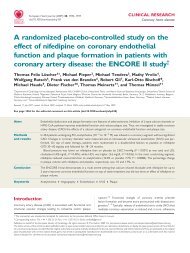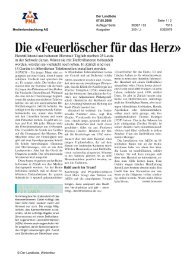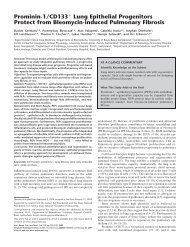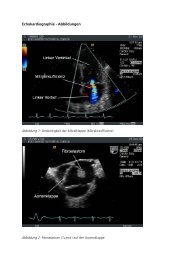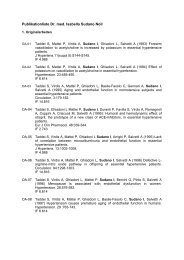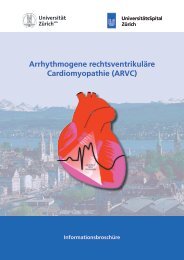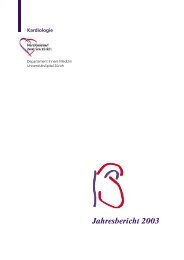Uric acid in chronic heart failure - ResearchGate
Uric acid in chronic heart failure - ResearchGate
Uric acid in chronic heart failure - ResearchGate
You also want an ePaper? Increase the reach of your titles
YUMPU automatically turns print PDFs into web optimized ePapers that Google loves.
University of Zurich<br />
Zurich Open Repository and Archive<br />
W<strong>in</strong>terthurerstr. 190<br />
CH-8057 Zurich<br />
http://www.zora.uzh.ch<br />
Year: 2008<br />
<strong>Uric</strong> <strong>acid</strong> <strong>in</strong> <strong>chronic</strong> <strong>heart</strong> <strong>failure</strong> - current pathophysiological<br />
concepts<br />
Doehner, W; Spr<strong>in</strong>ger, J; Landmesser, U; Struthers, A D; Anker, S D<br />
Doehner, W; Spr<strong>in</strong>ger, J; Landmesser, U; Struthers, A D; Anker, S D (2008). <strong>Uric</strong> <strong>acid</strong> <strong>in</strong> <strong>chronic</strong> <strong>heart</strong> <strong>failure</strong> -<br />
current pathophysiological concepts. European Journal of Heart Failure, 10(12):1269-1270.<br />
Postpr<strong>in</strong>t available at:<br />
http://www.zora.uzh.ch<br />
Posted at the Zurich Open Repository and Archive, University of Zurich.<br />
http://www.zora.uzh.ch<br />
Orig<strong>in</strong>ally published at:<br />
European Journal of Heart Failure 2008, 10(12):1269-1270.
Letter to the Editor<br />
Letter Title:<br />
<strong>Uric</strong> <strong>acid</strong> <strong>in</strong> <strong>chronic</strong> <strong>heart</strong> <strong>failure</strong>: look<strong>in</strong>g at the elephants tails.<br />
Re Article:<br />
Serum uric <strong>acid</strong> correlates with extracellular superoxide dismutase<br />
activity <strong>in</strong> patients with <strong>chronic</strong> <strong>heart</strong> <strong>failure</strong><br />
By Alca<strong>in</strong>o et al Eur J Heart Failure 10; 2008: 646-651<br />
Authors: Wolfram Doehner, MD, PhD [1]<br />
Jochen Spr<strong>in</strong>ger, PhD [1]<br />
Ulf Landmesser [2]<br />
Stefan D Anker, MD, PhD [1]<br />
Affiliation:<br />
[1] Division of Applied Cachexia Research, Department of Cardiology, Campus<br />
Virchow -Medical Center, Charité Medical School, Berl<strong>in</strong>, Germany<br />
[2] Kl<strong>in</strong>ik für Kardiologie, UniversitätsSpital Zürich and Kardiovaskuläre Forschung,<br />
Institut für Physiologie, Universität Zürich<br />
Correspond<strong>in</strong>g author:<br />
Wolfram Doehner, MD, PhD,<br />
Division of Applied Cachexia Research,<br />
Department of Cardiology, Charité Medical School,<br />
Campus Virchow-Medical Center, Augustenburger Platz 1,<br />
13353 Berl<strong>in</strong>, Germany<br />
Tel.: +49 30 450 553 507; Fax +49 450 553 951;<br />
E-mail: wolfram.doehner@charite.de<br />
We confirm there is no conflict of <strong>in</strong>terest, f<strong>in</strong>ancial or otherwise, <strong>in</strong> our submission of the<br />
manuscript.
To the Editor<br />
In their recent article Alca<strong>in</strong>o et colleagues report a beneficial effect of hyperuricaemia <strong>in</strong><br />
patients with <strong>chronic</strong> <strong>heart</strong> <strong>failure</strong> towards prevention of oxidative stress and improved<br />
endothelium function. The conclusions from this observational study <strong>in</strong> 38 patients with CHF<br />
are opposite to a substantial body of evidence. Therefore, we would like to make up for the<br />
authors shortfall to discuss these discrepancies and put the f<strong>in</strong>d<strong>in</strong>gs <strong>in</strong> perspective to current<br />
data.<br />
Most importantly, based on the presented background the hypothesis of the study reveals a<br />
serious misconception of the character of hyperuricaemia <strong>in</strong> CHF pathophysiology. Several<br />
studies are cited to support the role of UA as antioxidant to prevent oxidative damage <strong>in</strong>clud<strong>in</strong>g<br />
endothelium dysfunction. All these studies, however, tested the impact of adm<strong>in</strong>istration of<br />
exogenous uric <strong>acid</strong> not the impact of endogenous physiologically derived uric <strong>acid</strong>. While<br />
exogenous uric <strong>acid</strong> may <strong>in</strong>deed function to scavenge free oxygen radicals, it is of utmost<br />
importance to appreciate the orig<strong>in</strong> of elevated UA levels <strong>in</strong> CHF. It has sufficiently been shown<br />
by direct assessment of xanth<strong>in</strong>e oxidase XO [i] as well as <strong>in</strong>directly from allopur<strong>in</strong>ol therapy<br />
studies [ii] that elevated XO activity the predom<strong>in</strong>ant cause of hyperuricaemia <strong>in</strong> CHF.<br />
Importantly, the uric <strong>acid</strong> generat<strong>in</strong>g enzyme XO is one of the major sources of oxygen free<br />
radicals <strong>in</strong> human physiology. In fact, as early as 1968 the cytosolic XO was the first<br />
documented biological generator of oxygen derived free radicals [iii]. It seems an <strong>in</strong>defensible<br />
hypothesis to suggest hyperuricaemia as an adaptive process <strong>in</strong> response to the <strong>in</strong>creased<br />
ROS accumulation if the UA and ROS are generated <strong>in</strong> parallel by up-regulated XO. Moreover,<br />
the suggestion that this process <strong>in</strong> CHF “is lead<strong>in</strong>g to a raise <strong>in</strong> ecSOD activity and thus<br />
preserv<strong>in</strong>g endothelial function” has clearly been disproved as SOD and endothelium<br />
dysfunction are decreased <strong>in</strong> CHF well <strong>in</strong> parallel to disease severity.<br />
The idea that elevated (endogenous) UA levels may exert a beneficial effect on endothelium<br />
function and prognosis as discussed by the authors is <strong>in</strong> contrast to a large number of studies<br />
on vascular function [i, ii, iv, v] and mortality [vi, vii, viii] <strong>in</strong> <strong>heart</strong> <strong>failure</strong> patients and several<br />
2
other cardiovascular diseases <strong>in</strong>clud<strong>in</strong>g stroke [ix], cardiovascular risk [x], hypertension and<br />
renal disease [xi] as well as <strong>in</strong> normal populations [xii, xiii, xiv, xv]. Any attempt to <strong>in</strong>clude a<br />
representative number of all papers that provide data and conclusions that are opposite to the<br />
paper by Alca<strong>in</strong>o et al. would be stopped short due to limitation of space.<br />
Similarly the <strong>in</strong>terpretation of UA as a risk marker at early CHF but as beneficial factor at<br />
advanced stages does not withstand reality as studies show l<strong>in</strong>ear associations of UA with<br />
disease severity [iv, xvi, xvii], mortality and impaired vascular function [v].<br />
While the ongo<strong>in</strong>g scientific discussion regard<strong>in</strong>g the role of uric <strong>acid</strong> as active contributor vs<br />
passive marker is <strong>in</strong>deed ongo<strong>in</strong>g, Alca<strong>in</strong>o et al slipped <strong>in</strong> the mis<strong>in</strong>terpretation of the absence<br />
of evidence as evidence of absence: If previous studies us<strong>in</strong>g allopur<strong>in</strong>ol treatment could not<br />
prove a detrimental effect of UA itself this may by no means allow to conclude for a<br />
compensatory (i.e. beneficial) role of uric <strong>acid</strong>. The references quoted by Alca<strong>in</strong>o et al <strong>in</strong> support<br />
of their view are at least <strong>in</strong> part [xviii, xix] neither stat<strong>in</strong>g nor <strong>in</strong>tend<strong>in</strong>g this message. In fact, a<br />
recent study to test the effect of UA lower<strong>in</strong>g without XO <strong>in</strong>hibition us<strong>in</strong>g uricase has shown no<br />
effect on endothelial function [xx].<br />
Alca<strong>in</strong>o et al seem<strong>in</strong>gly base their study on the theory by Reyes that diuretic dependent<br />
<strong>in</strong>crease <strong>in</strong> UA conveys improved prognosis <strong>in</strong> cardiovascular patients [xxi]. Whether the rise of<br />
uric <strong>acid</strong> caused by diuretic treatment may exert beneficial effect on antioxidant capacity is,<br />
however, the wrong question to ask and resembles the attempt to describe an elephant from<br />
look<strong>in</strong>g at its tail. The potential contribution of this particular cause to elevated UA cannot be<br />
looked at separately from other mechanisms to <strong>in</strong>crease UA <strong>in</strong> CHF. Elevated UA levels <strong>in</strong> CHF<br />
result likely from a comb<strong>in</strong>ation of <strong>in</strong>creased XO activity (i.e. overproduction, see above) and to<br />
some degree impaired excretion follow<strong>in</strong>g impaired renal function and diuretic use. The isolated<br />
effect of the diuretic dependent UA <strong>in</strong>crease <strong>in</strong> this context is, however, negligible as only the<br />
effect of total UA elevation may - or may not – be cl<strong>in</strong>ically relevant. The theory by Reyes that<br />
diuretic dependent <strong>in</strong>crease <strong>in</strong> UA conveys improved prognosis <strong>in</strong> cardiovascular patients has<br />
previously been challenged [xxii] an is conv<strong>in</strong>c<strong>in</strong>gly refuted by a multitude of studies that show<br />
3
that (global) hyperuricaemia is a strong marker of disease severity and impaired prognosis (see<br />
above).<br />
Further, the assertion of the authors to address a previously not <strong>in</strong>vestigated association<br />
between UA, SOD activity and endothelium function is <strong>in</strong> negation of several papers that<br />
particularly evaluated these <strong>in</strong>teractions [i, ii, v]. Notably, the f<strong>in</strong>d<strong>in</strong>gs on the impact of UA <strong>in</strong><br />
CHF <strong>in</strong> these previous studies were opposite to the results by Alca<strong>in</strong>o. Unfortunately, these<br />
discrepancies were not discussed. The authors comment that UA levels <strong>in</strong> their study were<br />
with<strong>in</strong> normal limits <strong>in</strong> the majority of patients, however, not such data is presented. In the<br />
studied CHF patient group UA levels were abnormally elevated (7.3±2.3 mg/dl) and the<br />
comparison with the control subjects revealed significantly elevated UA levels <strong>in</strong> CHF patients<br />
(p
highlight of course the responsibility of the Journal to ensure a thorough and high quality peer<br />
review<strong>in</strong>g process.<br />
A rope is a rope is a rope. To recognise the shape and nature of the elephant might not be<br />
possible from the isolated gaze at its tail but requires an <strong>in</strong>tegrative <strong>in</strong>ter-coord<strong>in</strong>ated and<br />
repeatedly verified approach.<br />
REFERENCES<br />
i Landmesser U, Spiekermann S, Dikalov S, Tatge H, Wilke R, Kohler C, Harrison DG, Hornig B, Drexler<br />
H. Vascular oxidative stress and endothelial dysfunction <strong>in</strong> patients with <strong>chronic</strong> <strong>heart</strong> <strong>failure</strong>: role of<br />
xanth<strong>in</strong>e-oxidase and extracellular superoxide dismutase. Circulation. 2002;106:3073-3078.<br />
ii Doehner W, Schoene N, Rauchhaus M, Leyva-Leon F, Pavitt DV, Reaveley DA, Schuler G, Coats AJS,<br />
Anker SD, Ra<strong>in</strong>er Hambrecht. The effects of xanth<strong>in</strong>e oxidase <strong>in</strong>hibition with allopur<strong>in</strong>ol on endothelial<br />
function and peripheral blood flow <strong>in</strong> hyperuricemic patients with <strong>chronic</strong> <strong>heart</strong> <strong>failure</strong> – results from<br />
two placebo controlled studies. Circulation. 2002; 105: 2619-2624<br />
iii McCord JM, Fridovich I. The reduction of cytochrome c by milk xanth<strong>in</strong>e oxidase. J Biol Chem. 1968;<br />
243: 5753-5760.<br />
iv Doehner W, Rauchhaus M, Florea VG, Sharma R, Bolger AP, Davos, CH, Coats AJS, Anker SD. <strong>Uric</strong><br />
<strong>acid</strong> <strong>in</strong> cachectic and non-cachectic CHF patients - relation to leg vascular resistance. Am Heart J.<br />
2001;141:792-799<br />
v Maxwell AJ, Bru<strong>in</strong>sma KA. <strong>Uric</strong> <strong>acid</strong> is closely l<strong>in</strong>ked to vascular nitric oxide activity. Evidence for<br />
mechanism of association with cardiovascular disease. J Am Coll Cardiol. 2001;38:1850-8.<br />
vi Anker SD, Doehner W, Rauchhaus M, Sharma R, Francis D, Knosalla C, Davos CH, Cicoira M,<br />
Shamim W, Kemp M, Segal R, Osterziel KJ, Leyva F, Hetzer R, Ponikowski P, Coats AJ. <strong>Uric</strong> <strong>acid</strong> and<br />
survival <strong>in</strong> <strong>chronic</strong> <strong>heart</strong> <strong>failure</strong>: validation and application <strong>in</strong> metabolic, functional, and hemodynamic<br />
stag<strong>in</strong>g. Circulation. 2003;107:1991-1997<br />
vii Pascual-Figal DA, Hurtado-Martínez JA, Redondo B, Antol<strong>in</strong>os MJ, Ruiperez JA, Valdes M.<br />
Hyperuricaemia and long-term outcome after hospital discharge <strong>in</strong> acute <strong>heart</strong> <strong>failure</strong> patients. Eur J<br />
Heart Fail. 2007;9:518-24.<br />
viii Jankowska EA, Ponikowska B, Majda J, Zyml<strong>in</strong>ski R, Trzaska M, Reczuch K, Borodul<strong>in</strong>-Nadzieja L,<br />
Banasiak W, Ponikowski P. Hyperuricaemia predicts poor outcome <strong>in</strong> patients with mild to moderate<br />
<strong>chronic</strong> <strong>heart</strong> <strong>failure</strong>. Int J Cardiol. 2007;115:151-5.<br />
ix Karagiannis A, Mikhailidis DP, Tziomalos K, Sileli M, Savvatianos S, Kakafika A, Gossios T, Krikis N,<br />
Moschou I, Xochellis M, Athyros VG. Serum uric <strong>acid</strong> as an <strong>in</strong>dependent predictor of early death after<br />
acute stroke. Circ J. 2007;71:1120-7.<br />
x Ioachimescu AG, Brennan DM, Hoar BM, Hazen SL, Hoogwerf BJ. Serum uric <strong>acid</strong> is an <strong>in</strong>dependent<br />
predictor of all-cause mortality <strong>in</strong> patients at high risk of cardiovascular disease: a preventive<br />
cardiology <strong>in</strong>formation system (PreCIS) database cohort study. Arthritis Rheum. 2008;58:623-30.<br />
xi Johnson RJ, Kang DH, Feig D, Kivlighn S, Kanellis J, Watanabe S, Tuttle KR, Rodriguez-Iturbe B,<br />
Herrera-Acosta J, Mazzali M. Is there a pathogenetic role for uric <strong>acid</strong> <strong>in</strong> hypertension and<br />
cardiovascular and renal disease? Hypertension. 2003;41:1183-90.<br />
xii Erdogan D, Gullu H, Caliskan M, Yildirim E, Bilgi M, Ulus T, Sezg<strong>in</strong> N, Muderrisoglu H. Relationship of<br />
serum uric <strong>acid</strong> to measures of endothelial function and atherosclerosis <strong>in</strong> healthy adults. Int J Cl<strong>in</strong><br />
Pract. 2005;59:1276-82.<br />
xiii Kato M, Hisatome I, Tomikura Y, Kotani K, K<strong>in</strong>ugawa T, Og<strong>in</strong>o K, Ishida K, Igawa O, Shigemasa C,<br />
Somers VK. Status of endothelial dependent vasodilation <strong>in</strong> patients with hyperuricemia. Am J Cardiol.<br />
2005;96:1576-8.<br />
xiv Strasak A, Ruttmann E, Brant L, Kelleher C, Klenk J, Conc<strong>in</strong> H, Diem G, Pfeiffer K, Ulmer H;<br />
VHM&PP Study Group. Serum uric <strong>acid</strong> and risk of cardiovascular mortality: a prospective long-term<br />
study of 83,683 Austrian men. Cl<strong>in</strong> Chem. 2008;54:273-84.<br />
5
xv Meis<strong>in</strong>ger C, Koenig W, Baumert J, Dör<strong>in</strong>g A. <strong>Uric</strong> <strong>acid</strong> levels are associated with all-cause and<br />
cardiovascular disease mortality <strong>in</strong>dependent of systemic <strong>in</strong>flammation <strong>in</strong> men from the general<br />
population: the MONICA/KORA cohort study. Arterioscler Thromb Vasc Biol. 2008;28:1186-92.<br />
xvi Leyva F, Anker S, Swan JW, Godsland IF, W<strong>in</strong>grove CS, Chua TP, Stevenson JC, Coats AJ. Serum<br />
uric <strong>acid</strong> as an <strong>in</strong>dex of impaired oxidative metabolism <strong>in</strong> <strong>chronic</strong> <strong>heart</strong> <strong>failure</strong>. Eur Heart J.<br />
1997;18:858-65.<br />
xvii Olexa P, Olexová M, Gonsorcík J, Tkác I, Kisel'ová J, Olejníková M. <strong>Uric</strong> <strong>acid</strong>--a marker for systemic<br />
<strong>in</strong>flammatory response <strong>in</strong> patients with congestive <strong>heart</strong> <strong>failure</strong>? Wien Kl<strong>in</strong> Wochenschr.<br />
2002;114:211-5.<br />
xviii Doehner W, von Haehl<strong>in</strong>g S, Anker SD. <strong>Uric</strong> <strong>acid</strong> as a prognostic marker <strong>in</strong> acute <strong>heart</strong> <strong>failure</strong>--new<br />
expectations from an old molecule. Eur J Heart Fail. 2007;9:437-9.<br />
xix Gullu H, Erdogan D, Caliskan M, Tok D, Kulaksizoglu S, Yildirir A, Muderrisoglu H. Elevated serum<br />
uric <strong>acid</strong> levels impair coronary microvascular function <strong>in</strong> patients with idiopathic dilated<br />
cardiomyopathy. Eur J Heart Fail. 2007;9:466-8.<br />
xx War<strong>in</strong>g WS, McKnight JA, Webb DJ, Maxwell SR. Lower<strong>in</strong>g serum urate does not improve endothelial<br />
function <strong>in</strong> patients with type 2 diabetes. Diabetologia. 2007;50:2572-9.<br />
xxi Reyes AJ. The <strong>in</strong>crease <strong>in</strong> serum uric <strong>acid</strong> concentration caused by diuretics might be beneficial <strong>in</strong><br />
<strong>heart</strong> <strong>failure</strong>. Eur J Heart Fail. 2005;7:461-7.<br />
xxii Sr<strong>in</strong>ivas TR, Herrera-Acosta J, Feig DI, Kang DH, Segal MS, Johnson RJ. Diuretic-<strong>in</strong>duced<br />
hyperuricemia does not decrease cardiovascular risk. J Hypertens. 2004;22:1415-7;<br />
xxiii Farquharson CA, Butler R, Hill A, Belch JJ, Struthers AD. Allopur<strong>in</strong>ol improves endothelial<br />
dysfunction <strong>in</strong> <strong>chronic</strong> <strong>heart</strong> <strong>failure</strong>. Circulation. 2002;106:221-6.<br />
xxiv George J, Carr E, Davies J, Belch JJ, Struthers A. High-dose allopur<strong>in</strong>ol improves endothelial<br />
function by profoundly reduc<strong>in</strong>g vascular oxidative stress and not by lower<strong>in</strong>g uric <strong>acid</strong>. Circulation.<br />
2006;114:2508-16.<br />
6


